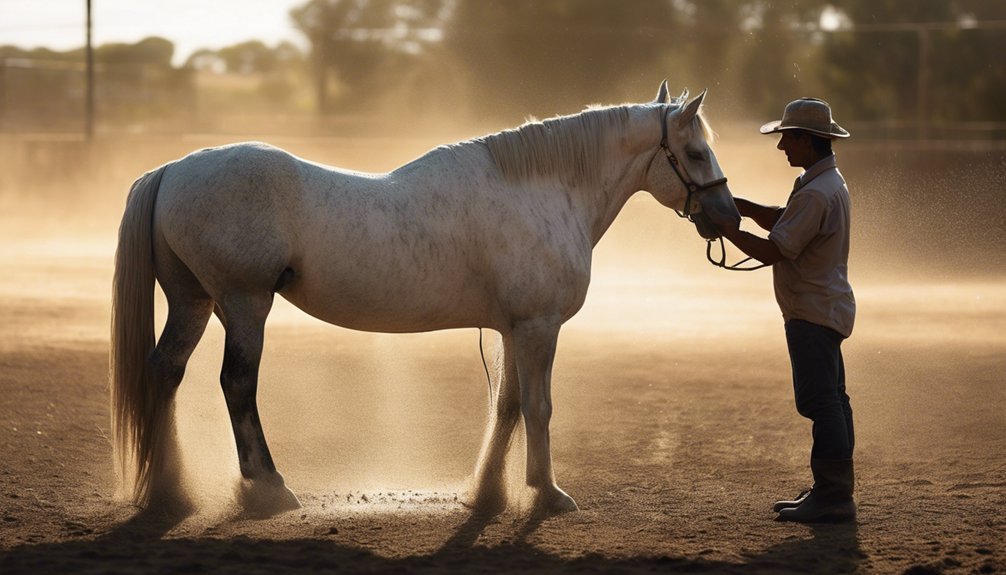
Grooming your horse in dusty environments requires a thoughtful approach to ensure both their health and comfort. You'll need the right tools, like curry combs and brushes, to effectively manage the dirt and debris. Regular grooming not only keeps your horse looking good but also strengthens your bond. However, you might be overlooking some key techniques that can make a significant difference in your grooming routine. Let's explore those essential strategies.
Key Takeaways
- Groom daily to remove dust and reduce respiratory issues, enhancing your horse's overall health and appearance.
- Use a quality curry comb in circular motions to loosen embedded dirt before brushing.
- Employ stiff brushes to flick away dust and softer brushes for sensitive areas to avoid irritation.
- Maintain well-ventilated grooming areas to minimize airborne dust and improve air quality.
- Provide a balanced diet and hydration to support skin health and combat dryness from dust exposure.
Understanding the Impact of Dust on Horses

Although dust might seem like a minor nuisance, it can significantly impact your horse's health and well-being. Prolonged dust exposure can lead to serious respiratory issues, affecting your horse's ability to perform and enjoy life.
Dust particles can irritate the airways, causing inflammation and making breathing difficult. You'll notice signs like coughing, nasal discharge, or labored breathing, which indicate that your horse's respiratory health is compromised.
To combat these effects, consider minimizing dust in their environment by regularly cleaning stalls and using appropriate bedding. When grooming, do so in a well-ventilated area to reduce airborne particles.
Being proactive about your horse's exposure to dust can go a long way in ensuring they remain healthy and happy, so pay close attention to their surroundings.
Essential Grooming Tools for Dusty Conditions
When grooming your horse in dusty conditions, having the right tools can make all the difference in maintaining their health and comfort.
Start with high-quality grooming brushes designed to effectively remove dirt and debris without irritating your horse's skin. A stiff brush is perfect for loosening caked-on dust, while a softer brush can help smooth the coat afterward.
Don't forget a good hoof pick to clear out any dust or stones stuck in their hooves. To protect yourself, wear dust masks; they'll help filter out particles that can irritate your respiratory system while you work.
With these essential tools, you'll keep your horse's coat shiny and healthy, and you'll enjoy a more comfortable grooming experience.
Establishing a Regular Grooming Routine

Establishing a regular grooming routine not only enhances your horse's appearance but also contributes significantly to their overall health and well-being.
Aim for a grooming frequency that suits both your schedule and your horse's needs; daily grooming is ideal, especially in dusty environments. This routine helps you build a bond with your horse, allowing you to check for injuries or irritations while removing dirt and debris.
The routine benefits include improved circulation and a healthier coat, making your horse feel more comfortable and happy. Plus, it can be a calming experience for both of you, reinforcing trust and connection.
Techniques for Effective Dust Removal
Effective dust removal is crucial for maintaining your horse's health and comfort. To achieve effective dust control, start with a quality curry comb to loosen dirt and debris from your horse's coat.
Use firm, circular motions, focusing on areas where dust tends to accumulate. Follow up with a stiff-bristled brush to flick away the loosened particles. For sensitive areas, switch to a softer brush to avoid irritation.
Don't forget to pay attention to the mane and tail; a mane comb can help detangle while removing dust. Regularly check your horse's hooves, using a hoof pick to clear out any debris.
These grooming techniques not only keep your horse clean but also strengthen your bond through the nurturing process.
Bathing Your Horse in Dry Environments

After you've tackled dust removal, bathing your horse in dry environments presents its own set of challenges. Here, you'll want to ensure a comfortable experience for your horse while effectively cleaning their coat.
Consider these key points:
- Use lukewarm water temperature to avoid shocking their skin.
- Choose a gentle, moisturizing shampoo selection to prevent dryness.
- Bathe during the coolest parts of the day to minimize discomfort.
- Rinse thoroughly to remove all shampoo residue, which can irritate the skin.
- Follow up with a good brush to redistribute natural oils.
Maintaining Skin Health and Hydration
To keep your horse's skin healthy and hydrated, focus on a balanced approach that addresses both nutrition and care routines.
Start by ensuring your horse's diet includes essential fatty acids, which support skin health from the inside out. Regular grooming helps remove dust and debris, promoting better skin condition.
Incorporate skin moisturizers specifically formulated for horses to combat dryness, especially in dusty environments. Additionally, utilize hydration techniques like providing ample fresh water and electrolytes, especially after exercise.
Pay attention to areas prone to irritation, and if you notice any signs of discomfort, consult your veterinarian. Consistent care and attention will foster a strong bond with your horse while keeping their skin vibrant and resilient.
Tips for Cleaning Tack and Equipment

Maintaining your horse's overall health naturally extends to the care of their tack and equipment, which plays a vital role in your riding experience.
Regular tack cleaning and equipment maintenance not only enhance performance but also ensure your horse's comfort. Here are some essential tips for keeping your gear in top shape:
- Use a soft cloth or sponge to wipe down leather after each ride.
- Apply a quality leather conditioner to prevent cracking.
- Clean metal parts with a gentle brush to remove dirt and sweat.
- Store your tack in a cool, dry area to avoid mold.
- Inspect regularly for any signs of wear or damage.
Taking these steps will help maintain your gear, ensuring safer and more enjoyable rides with your beloved horse.
Creating a Dust-Free Environment for Your Horse
Creating a dust-free environment for your horse is essential for their respiratory health and overall well-being, especially if they spend time in a stable or barn.
Start by implementing effective dust control measures, such as using rubber matting in stalls to minimize dust and allergens.
Regularly clean and organize the stable, ensuring that bedding is kept dry and free from mold.
Invest in proper stable ventilation; good airflow reduces dust accumulation and keeps the air fresh.
Consider using fans or open windows to enhance circulation.
Additionally, wetting down dusty areas during cleaning can significantly decrease airborne particles.
Frequently Asked Questions
How Often Should I Groom My Horse in Dusty Conditions?
You should groom your horse daily in dusty conditions. Increased grooming frequency helps manage dust effectively, keeping your horse comfortable and healthy. Regular attention to their coat strengthens your bond and ensures they feel their best.
Can Dust Allergies Affect My Horse's Behavior?
Dust allergies can definitely affect your horse's behavior. You might notice increased irritability or restlessness. By managing their environment and grooming diligently, you can help minimize these effects and keep your horse feeling calm and comfortable.
What Signs Indicate My Horse Needs More Grooming?
If your horse's coat looks dull, feels rough, or has excessive dirt and debris, it's time to increase grooming frequency. Regular grooming promotes skin health and strengthens your bond, ensuring your horse feels comfortable and loved.
Is It Safe to Use a Vacuum on My Horse?
Using a vacuum on your horse can be safe, but ensure it's designed for equine use. Watch your horse's comfort; introduce it gradually, so they feel relaxed and secure during the grooming process.
How Can I Prevent Dust From Settling in My Horse's Stall?
Like a breath of fresh air, good stall ventilation keeps dust at bay. Install fans or windows for airflow, use rubber mats for easy cleaning, and regularly remove manure to enhance dust management. Your horse will thank you!
Conclusion
In dusty environments, regular grooming is crucial for your horse's health and comfort. Did you know that horses can lose up to 20% of their body weight in sweat during intense heat, which can be exacerbated by dust? By incorporating proper grooming techniques and tools, you not only keep your horse's coat clean but also enhance their overall well-being. Remember, a consistent routine strengthens your bond and keeps your horse healthy, happy, and ready to perform at their best.





